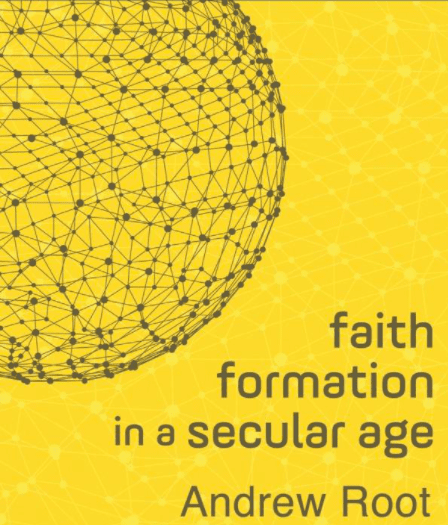 The age of authenticity (yesterday’s post) is the age of youthfulness. So Andrew Root, in his new splendid book Faith Formation in a Secular Age. How so?
The age of authenticity (yesterday’s post) is the age of youthfulness. So Andrew Root, in his new splendid book Faith Formation in a Secular Age. How so?
To tell the story of the dawn of the age of authenticity is to show how the flows of our cultural history have moved the majority of us to see the point of life as following not an external authority but the inner search for our own individual meaning and purpose. The age of authenticity asserts that we should be directed by nothing outside us but only by what we find meaningful within us. Youthfulness becomes the late twentieth century’s core strategy for denying external authority (even divine action) to follow the new purpose of “what speaks to me.” Youthfulness promises particular social practices—like sex, drugs, and consumerism—as ways to achieve authenticity.
WW1 and then WW2, the wars that did not end war but become the Cold War, and the USA developing Keynesian economics of consumerism as how the economy is propped up. Our economy boomed as Americans became spenders.
The operative words of our society after WW2 were duty, obligation, and authority.
A draft was in place during World War II, but it is little talked about because it was duty and responsibility, not the draft, that sent men east and west to fight and die. To wait to be asked (in other words, to be obligated) to risk life and limb for country would have been considered outrageous before the age of authenticity. Yet the draft was the core staple of revolt and protest of Vietnam, as the youth burned draft cards and bras. … v’hat ignited the flames of rebellion in the 1960s, as much as matches, was the arrival of authenticity—the idea that your own path, your own desires and wishes, must lead you before any duty or obligation. … Bras went up in flames with draft cards as a way to mutually protest obligation and duty that had no correlation with the authenticity of individual desires. It made sense to protest sexual mores at the same time as war, for both instances the protest was against the authorities that oppose my authenticity.
The men and women of World War II are considered the greatest generation, and their greatness is legitimated by the historical moments they rose to face, but this greatness is also bound simply in our perception. We see these u i men and women through the prism of the age of authenticity, as the last generation before the age of authenticity dawned. They are great to us because they did something we cannot imagine: they followed duty and obligation over the desires of the self.
The generation gap in the 1960s was between duty/obligation and authenticity; today’s society is made up mostly of a generation of authenticity.
How did this happen? The generation of duty decided their duty, after fulfilling their duty to society, was to have a duty to buy. To move to the suburbs, to buy a house, to get education, to carry on. The age of duty gives way to the age of authenticity, which becomes the age of consumerism. The duty was to participate in a mass society by sustaining its economy.
The age of authenticity enters the scene through the act of consumer duty. Yet once a generation comes of age in the womb of a consumer society (i.e. the boomers), the cords that precariously connect consumption and duty are cut, and authenticity becomes our new social imaginary.
The 1950s were the last days of duty: “Duty shows itself fervent when there is conformity in action, attitude, and dress; these are the marks that duty is highly operational” (22). This duty operated outside transcendence; it was immanent and natural. WW2 was connected to freedom, and freedom was connected to the gift and revelation of God. The Cold War had a theological connection because it was anti godless atheism, but deeper down it was the protection of consumerism.
The affluence of the post WW2 society choked out duty and opened the door to expressivistic authenticity. The large middle class became the age of authenticity. The youth of the middle class lived in suburbs and played on plush green lawns surrounded by other middle class children who didn’t have to work to grind out a life. Youth became adolescence. The rural population lived with duty; the suburbanites and city folks not so much. Their job was to play. Toys became big business.
Segmentation and advertising were connected. One’s segment in society — youth — became the silo in which one lived and consumed. This segmentation separated adults from children, and each conformed to each.
It was the mass society and its extensive invasion into the middle class (for mostly white people), creating for their children a duty-free space, that turned this ancient concern for the young into a new social imaginary of youthfulness.
HS graduation became the norm for the first time. [This is mostly a description of white culture, folks.] Children went to college not to return to the family farm or business but to explore their own career.
Enter the James Dean rebel against conformity.
The rebel revealed that the middle-class affluence of the mass society was no free ride, that while the young were given space and freedom, a hidden reciprocity was in place—the young take the freedom, becoming teenagers, free from direct duty and obligation to focus on the music, cars, and clothes of their segmentation. But in return, they accept conformity, following the rules and taking the path marked from letter jacket to gray flannel suit and starched plaid dress.
Enter Christian resistance.
The call to conformity of the mass society and the hidden but nascent conditions of an expressive individualism made it a perfect time for conservative Christians to reengage society. And part of the mission of their reengagement was directed toward the segmented group called teenagers. Organizations like Youth for Christ and Young Life turned their attention to the middle-class high school as their new mission field. Young Life, for instance, believed that if it could convince the most successful high school students, the models of conformity—say, the captain of the football team and the homecoming queen—to come to its weekly club, then others would in turn conform and follow. The mass society and its magnetic pull of conformity could draw many, if you could simply get the right magnet to participate.
Segmentation: to the young, by the young, for the young. Youthfulness abounds. Would the church’s youth’s conformity age into adult church conformity.
Participation in youth groups was a choice, a kind of consumerism in a segmented group. Measurement was by way of participation. That is, by conformity to a group. Transcendence is not the focus.











